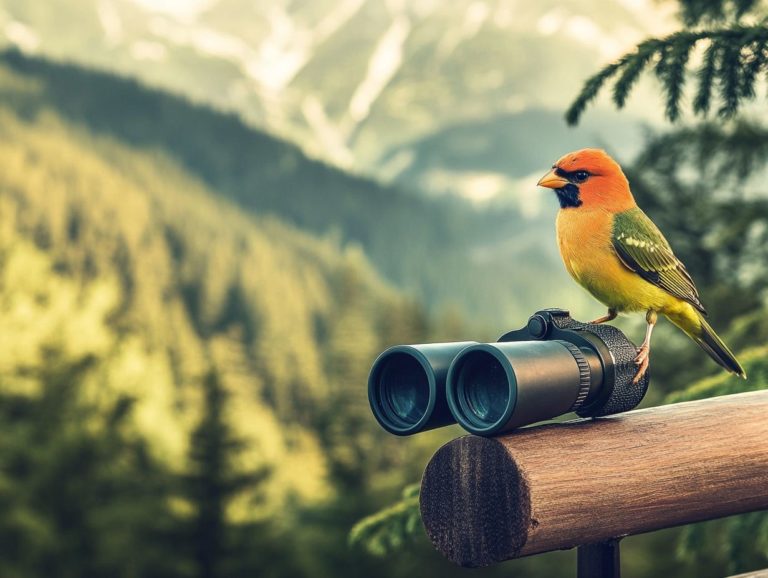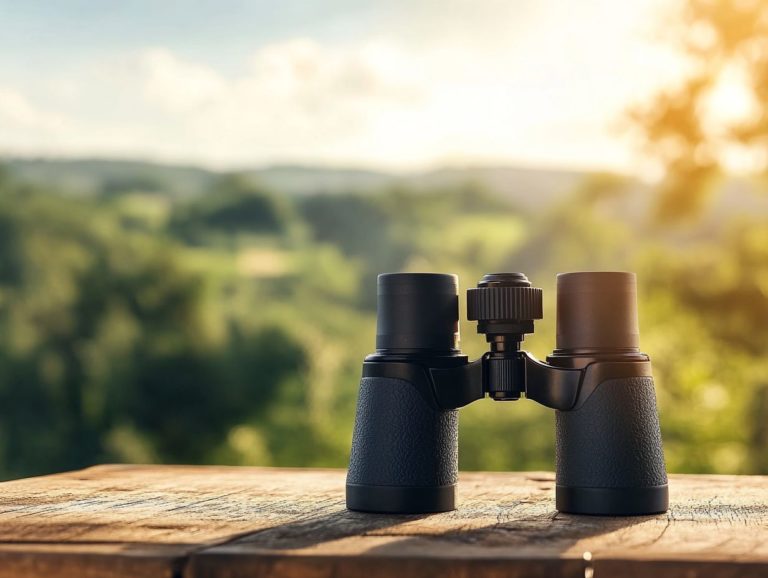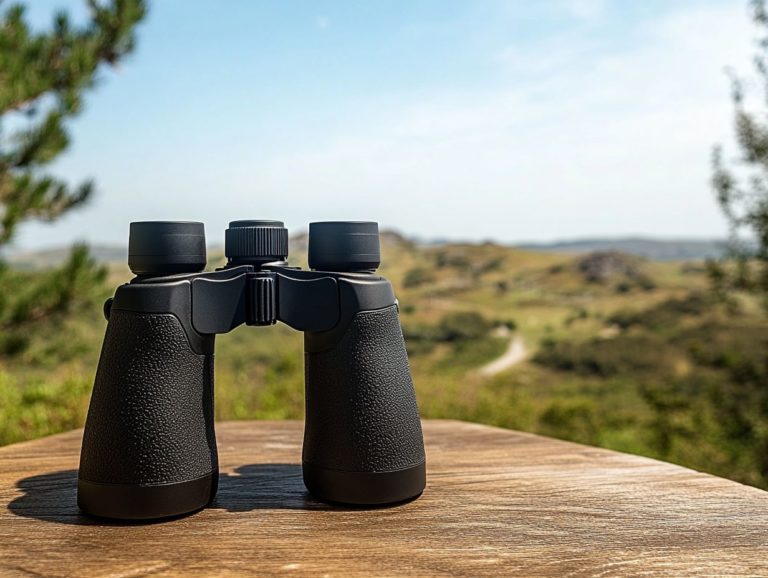How Binoculars Enhance Your Bird Watching Experience
Bird watching goes beyond just a hobby; it s your pathway to connecting with nature and appreciating the exquisite beauty of avian life.
As its popularity blossoms, binoculars can significantly elevate this experience, allowing you to see details you might otherwise miss. This article delves into the fundamentals of bird watching, highlights the benefits of using binoculars, and guides you in selecting the perfect pair for your adventures.
You ll also discover valuable tips and potential pitfalls to maximize your time in the field. Get ready to take your bird watching adventure to thrilling new heights!
Contents
- Key Takeaways:
- The Basics of Bird Watching
- Benefits of Using Binoculars for Bird Watching
- Choosing the Right Binoculars for Bird Watching
- Tips for Using Binoculars in Bird Watching
- Common Mistakes to Avoid
- Frequently Asked Questions
- What are binoculars and why are they important for bird watching?
- How do binoculars enhance the bird watching experience?
- What features should I look for when choosing binoculars for bird watching?
- Can I use any type of binoculars for bird watching?
- How do I use binoculars for bird watching?
- Can children also use binoculars for bird watching?
Key Takeaways:
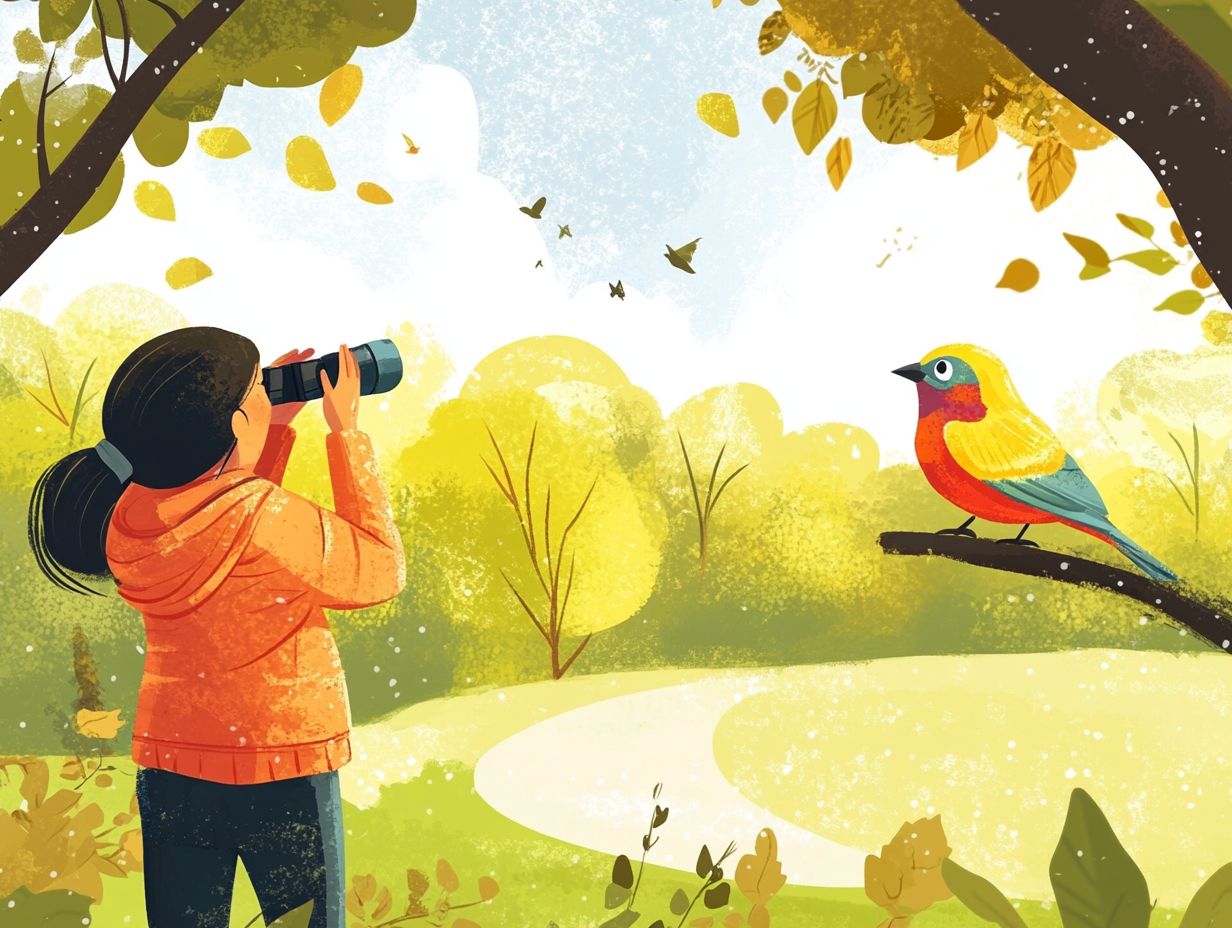
- Enhance your bird watching experience with binoculars.
- Improve viewing and identification with binoculars.
- Choose the right binoculars and use proper techniques for maximum results in bird watching.
The Basics of Bird Watching
Birdwatching is an enriching outdoor pursuit that immerses you in the stunning world of avian life across various ecosystems.
Locations like the Audubon Center offer a unique opportunity to observe the vibrant bird populations of the Americas.
Engaging in this activity not only deepens your appreciation for nature but also supports vital conservation efforts, making it a beloved pastime for both conservationists and nature enthusiasts.
What is Bird Watching?
Bird watching is the art of observing birds in their natural habitats, often enhanced by the use of high-quality binoculars that provide a clearer view of these captivating creatures.
This engaging hobby draws enthusiasts from all walks of life, offering a unique opportunity for you to connect with nature and witness the diverse behaviors of various avian species.
The thrill of spotting rare birds, identifying different breeds, and understanding their migratory patterns can be particularly exhilarating.
Binoculars are essential, providing the magnification and clarity needed to appreciate the finer details, such as the stunning colors of their plumage and their intricate movements. To ensure you get the best experience, learn how to use binoculars for bird watching safely.
Venturing into local parks, wetlands, or nature reserves can transform an ordinary outing into an exhilarating adventure, brimming with discovery and tranquility.
Why is it Popular?
The popularity of birdwatching has soared in recent years, primarily because it allows you to connect deeply with nature while contributing to a growing awareness of ecosystems across the Americas.
This movement has fostered a vibrant community of passionate conservationists.
Several factors have driven this surge. The rise of social media plays a significant role, as enthusiasts share their sightings and experiences, cultivating a sense of camaraderie among birdwatchers.
Extensive research showcases the health benefits of spending time outdoors, such as reduced stress levels and enhanced mental well-being, encouraging more individuals to embrace this fulfilling hobby.
Technological advancements in equipment, such as high-quality binoculars and smartphone apps for identification, have made birdwatching even more accessible and engaging.
This has attracted a diverse range of people eager to explore the wonders of the natural world.
Benefits of Using Binoculars for Bird Watching
Utilizing binoculars transforms your birdwatching experience, offering you a crisp view of distant avian wonders. For more insights on how these tools enhance your observations, check out the importance of binoculars in birding, as they also enhance brightness for a brilliantly vivid image.
This clarity is essential for effective observation, no matter the environment you find yourself in.
Improved Viewing Experience

A quality pair of binoculars enhances your birdwatching experience. To further elevate your outings, consider learning how to use accessories to enhance bird watching. They offer optimal magnification, an adjustable field of view, and a design for comfort during long use.
With the right magnification, you can observe the intricate details of bird features from a distance. This allows you to appreciate their vibrant plumage and subtle behaviors.
A wider field of view makes tracking fast-moving birds easy as they dart between trees or glide across the sky. This combination enriches your overall observation experience and boosts your confidence in identifying various species.
A thoughtfully designed pair, often featuring ergonomic grips and lightweight materials, ensures you can comfortably carry them on extended outings. This design makes every birdwatching adventure enjoyable and fulfilling.
Enhanced Identification and Observation
With the integration of AI image recognition technology, binoculars have transformed birdwatching. You can now recognize different bird species quickly and accurately.
This exciting innovation makes spotting and identifying birds easier than ever! Advanced algorithms work in real-time, sifting through extensive databases of avian species to provide detailed insights into their characteristics and behaviors.
As you use these high-tech tools, you can access augmented reality features that visualize essential data, such as habitat preferences or migratory paths. This elevates your birdwatching experience to an engaging educational adventure.
By bridging the gap between nature and technology, you create a more immersive and enjoyable encounter with the world of birds.
Choosing the Right Binoculars for Bird Watching
Selecting the perfect binoculars for birdwatching requires understanding various specifications and features. Consider factors such as magnification and objective lens size. Think about whether compact or full-size binoculars suit your needs best.
This thoughtful approach will enhance your birdwatching experience, allowing you to fully appreciate the beauty of nature.
Factors to Consider
When choosing binoculars for birdwatching, consider magnification, objective lens size, field of view, and the distance between your eyes. Understanding the evolution of binocular technology for birders can also enhance your selection process. These elements are crucial for a comfortable and effective viewing experience.
Each factor significantly influences how much you enjoy spotting bird species in their natural habitats. Magnification allows you to see intricate details from afar. It reveals stunning plumage patterns and subtle colors you might otherwise miss.
The size of the objective lens is vital for light transmission, especially during those magical early morning or late afternoon hours when birds are most active.
The field of view dictates how much terrain you can observe at once, making tracking elusive flying birds easier. Comfort matters, so having the right fit is essential, allowing you to immerse yourself in birdwatching without straining your eyes.
By understanding these factors, you can make informed choices that ultimately enhance your experience in the great outdoors.
Tips for Using Binoculars in Bird Watching
To truly enhance your birdwatching experience with binoculars, it’s crucial to adopt the right techniques. For tips on using binoculars effectively for bird identification, fine-tune the design for your eye distance and maintain a steady hand to capture sharp images.
Proper Technique for Maximum Results
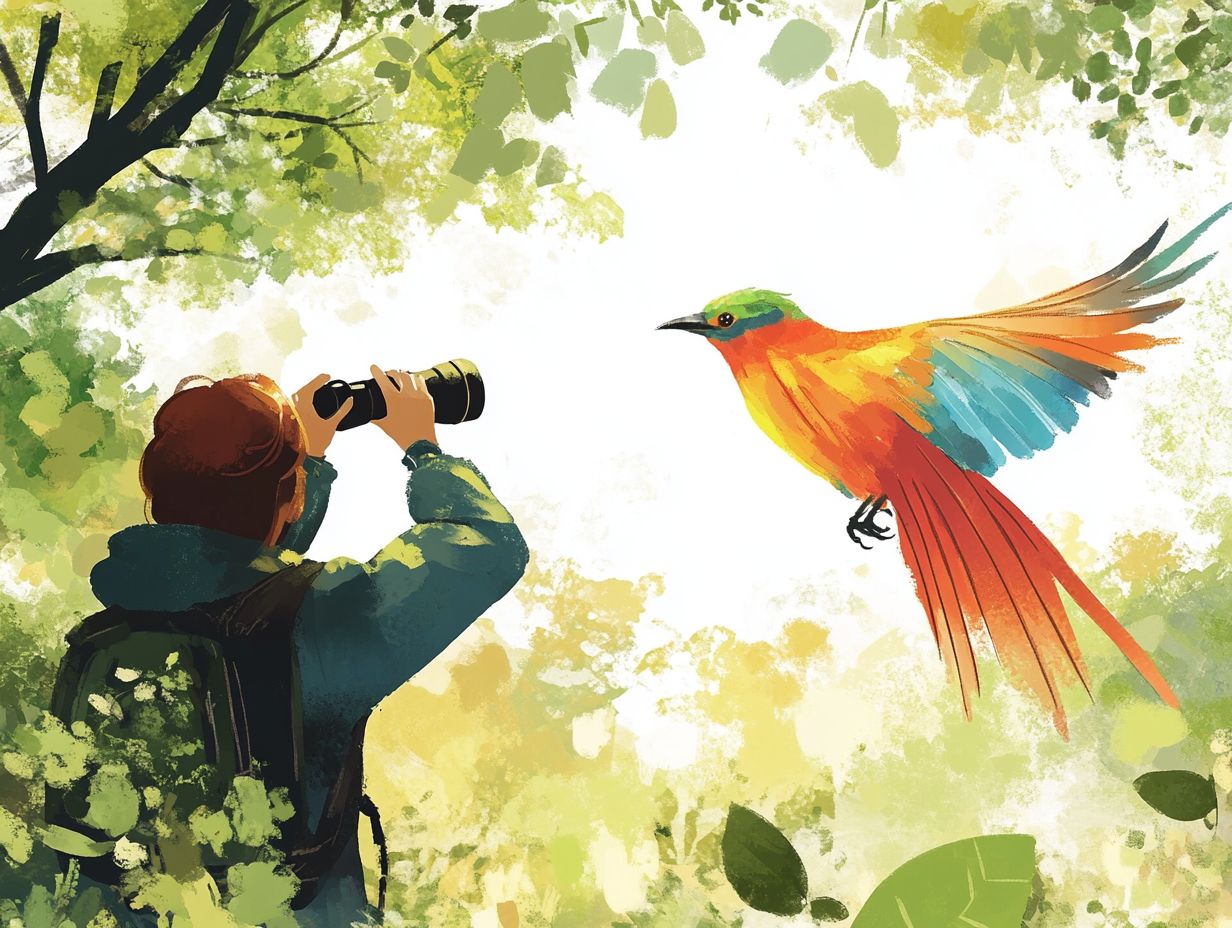
Using binoculars effectively requires a steady hand and an understanding of how magnification works. Learning the role of binoculars in bird conservation and mastering proper techniques will make your birdwatching experience much better!
To get the best view, focus carefully on your subject. This greatly affects the clarity and detail you see.
Try stabilization techniques, like resting your elbows on a solid surface or using a tripod. These can reduce shakes and jitters, making your experience enjoyable.
By applying these strategies, you ll become an avid birdwatcher. This leads to more rewarding sightings and a deeper appreciation for avian life.
Common Mistakes to Avoid
Birdwatching can be immensely rewarding, but certain pitfalls can detract from your experience.
For example, using low-quality binoculars can lessen your enjoyment. Neglecting to adjust settings for optimal clarity can also hinder your experience.
Ensuring you have the right equipment and making necessary adjustments will elevate your birdwatching to new heights.
How to Avoid Common Pitfalls
To avoid common pitfalls in birdwatching, invest in high-quality binoculars for exceptional visual clarity. Learning how to select binoculars for bird watching tours will help you use them to their fullest potential.
Choosing the right binoculars is crucial. They greatly impact your ability to spot and identify various species in their natural habitats, like shrubs or near a flagpole.
Look for options with at least 8x magnification. This means you see things 8 times closer than with the naked eye. Consider 8×32 for versatility or 10×42 for enhanced viewing.
Practicing proper techniques, such as maintaining a stable posture and using adjustable eyepieces, will help minimize movement and improve your spotting ability.
Familiarizing yourself with local bird species and their behaviors will allow you to anticipate their movements. This makes your excursions even more rewarding.
By combining quality equipment with strategic methods, you can elevate your birdwatching adventures, whether you’re using compact or marine binoculars. For an enhanced experience, consider the best binoculars for backyard bird watching. Immerse yourself in the enchanting world of avian life.
Frequently Asked Questions
What are binoculars and why are they important for bird watching?
Binoculars are optical instruments with two small telescopes mounted side by side. They allow for magnified viewing of distant objects, which is important for birdwatching. They help you see birds in greater detail and from a distance, without disturbing them.
How do binoculars enhance the bird watching experience?

Binoculars enhance the birdwatching experience by providing a closer and clearer view of birds. To further improve your outings, consider exploring top bird watching accessories that allow you to see their unique features and behaviors more easily.
They also simplify the process of identifying different bird species and observing them in their natural habitat.
What features should I look for when choosing binoculars for bird watching?
When selecting binoculars for birdwatching, consider the magnification power, lens diameter, and overall weight. Popular options include 10-power or 8-power binoculars.
A magnification power of at least 8x and a lens diameter of 42mm or higher are recommended for optimal viewing.
Choose lightweight binoculars for comfort during long periods of use, especially those designed for easy carrying.
Can I use any type of binoculars for bird watching?
While any binoculars can technically be used, it’s best to choose those designed specifically for birdwatching. These often include features like anti-glare coatings and waterproofing, making them suitable for outdoor use.
How do I use binoculars for bird watching?
First, adjust the binoculars to fit your eyes. Adjust the distance between the eyepieces and the focus.
Locate a bird with your naked eye. Then, bring the binoculars up to your eyes.
Use the focus knob until the bird appears clear. You can also adjust the zoom to get a closer look.
Can children also use binoculars for bird watching?
Yes, children can use binoculars designed just for them. These binoculars have lower zoom levels and are smaller for their hands.
Using binoculars can be a fun adventure! It helps children develop an interest in nature and wildlife.


